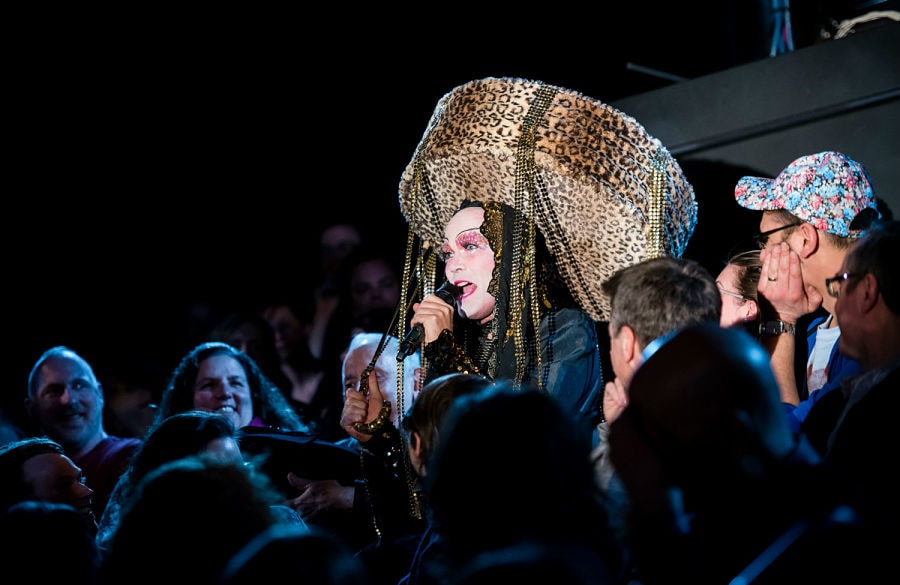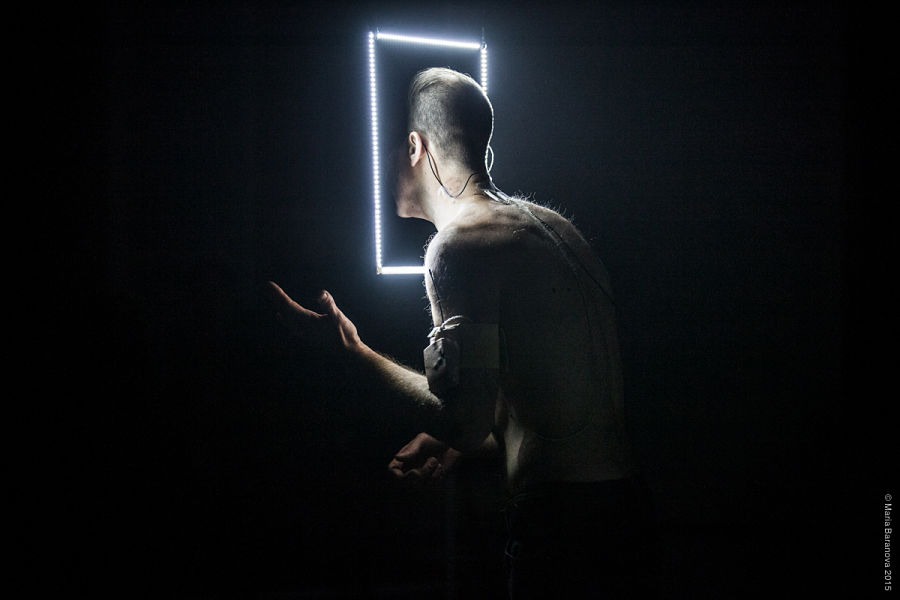About a half hour before I was supposed to be at COIL show called The Blind Date Project, I discovered I was headed to the wrong performance at the wrong theatre on the wrong night. I was supposed to be seeing a play about a man running late to a blind date and somehow I was on my way to a show about robots. I was only halfway through my New York January theatre festival binge of 16 shows in 12 days, and it was far too early to have lost my grip on my schedule. There was a lot more challenging and mind-bending theatre to see.
I checked out work at five festivals this year: Under the Radar, COIL, PROTOTYPE, Special Effects and American Realness. These festivals make a home for work that does not easily fall into simple categories or marketable blurbs, but all are focused on where the art of performance is going. Nearly every festival show I saw pushed at the boundaries of theatre and asked, quite puckishly, What if I tried this? I saw performers stroll through the audience asking provocative questions of the audience, stumble drunk through a karaoke bar and sing off-key, preen in a box, recite poetry from a podium or ask everyone to shout out their dreams. After seeing 200 shows in 2014, I thought I had seen everything, but these festivals surprised me with work that has reframed how I look at theatre and has made me want to spend more time outside the box.
The following were some of the highlights that helped me kick off 2015 in the best possible way.
YOUARENOWHERE (COIL): As I wandered into Andrew Schneider’s show, I did not realize I would walk out a changed person—broken and rebuilt, optimistic and electrified. The show started with a shirtless man who had wires coming from packs on his biceps and he started talking. I was laughing. Lights flashed, static squelched, he fell, he sang, he pleaded, he made a presentation on the theory of relativity, he talked about love, time, the past, memory, dying, consciousness and experience. And then everything I thought I knew about theatre disappeared and he genuinely surprised me.
It’s easy after a lifetime of going to the theatre to become acclimated to its tricks and conventions. But Schneider broke all of that. He found a way not only to undermine my expectations but also somehow to convert his performance into atomic energy and blow up everything in its wake. I was sitting amid emotional rubble, and then he danced. I’m being intentionally coy about the substance of the work and the coup de théâtre at its center because my hope is that the show returns and more people get to experience it. I’m incapable of balancing my boundless love of this show with the need to temper expectations. But I’ll admit that part of the wonder came from walking in totally blind and walking out feeling like I’d been given X-ray vision.

A 24-Decade History of Popular Music 1900s-1950s (Under the Radar): Taylor Mac has been previewing his planned epic 24-hour durational project, which will explore the history of American popular music from 1776 to 2016. For now, Mac is performing segments covering the 1900s to the 1950s. Judy (Mac’s preferred pronoun) is giving recontextual makeovers to American songbook classics by focusing on queer history. Sitting at his feet onstage, we got to hear chapters of American history the textbooks leave out. Mac’s unconventional storytelling and staging choices elevated the songs—there’s nothing like hearing a song from the Jewish tenements of the 1900s when the entire audience is out of their seats, squished up close to all their neighbors onstage to hear it. And if you think you’ve already heard “Danny Boy” too many times, Mac proved you need to hear it again the way he’s chosen to sing it, because it was like hearing it for the first time.
Asking for It (Special Effects): Adrienne Truscott’s freewheeling show about rape jokes and standup comedy made a meal of uncomfortable laughter. Performing much of the show naked from the waist down, with elements of burlesque, performance art and a strong commitment to audience discomfort (including some audience interaction), Truscott’s was a standup routine that was wholly self-aware. She went about deconstructing the mechanics of comedy but remaining true to her thesis that if you’re going to make a joke about rape, it better damn be funny. She was funny, touching, angry and righteous. As she said, “It’s been a big year in rape and comedy…Every year it is.” We need this show now more than ever. The show will return in April at Joe’s Pub.
My Voice Has an Echo in It (COIL): Kenneth Collins and Temporary Distortion played games with the concept of intimacy in this six-hour durational work. The performers were ensconced in a large box with two-way mirrors all around, and the audience stood on the outside with headphones on. Looking through the mirror allowed us to be intensely close to the performers as they recited poetry, strummed guitars and slammed drums, though what we hear was controlled and distorted. For all our physical proximity, there was still a distance constructed through sound. And though we may have observed the artists up close, they were not giving away all their secrets.
Layers of light and images were compounded by the mirrors, so that at times looking into the box was like staring into an endless, sparkling abyss. The energy of the performances rose and feel. We were meant to come and go as we pleased. For me, they created such a rich, evocative space, I wanted to get lost in it. I stayed for three hours but wish I’d been there for all six.
A Living Documentary (American Realness): Cynthia Hopkins pulled no punches in addressing the challenges facing artists today. Looking at her own financial hardship and feeling disillusioned in her own work, Hopkins explored the dilemma of having creative success which still can lead to financial ruin. She wanted artists to consider whether the dreams they started with are the dreams they are actually living. In her own case, this solo show—which incorporates multiple fictional characters, personal biography and songs—amounted to a confession that she found herself wanting to fail so she could be free to go a different direction. For all the tough talk, though, there was hope, humor and renewal in her message. One character, a sassy career-development guru, kicked the audience into gear and demanded that artists respect themselves or no one else will, arguing memorably that they need to grow “spiritual testicles.” Hopkins’s show made a strong case for artists to stay in control of their dreams, even if that sometimes means walking away.
Timur and the Dime Museum (PROTOTYPE): This L.A. band previewed some songs from their post-ecological requiem for the natural world, Collapse, which will play in New York in the fall. It was my first experience with their glam rock/polka/opera/cabaret delightfulness and odd/charming rock-star kookiness. You have to see them to understand their multi-hyphenate joie de vivre. I left with a smile on my face and a desire to see them again.
Indeed, I felt much the same about the best shows in this busy festival January. If these are the places where performance is going, count me in.
Nicole Serratore is a theatre lover based in New York. She blogs at Mildly Bitter’s Musings and talks all things theatre on the Maxamoo podcast.


